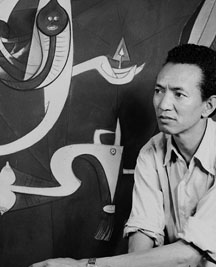Cuba’s Censored Art Movement
Grupo Antillano: Cuba’s Afro-descendant Art Movement
[Extended Reading Available: http://www.queloides-exhibit.com/grupo-antillano/index.html]
Grupo Antillano (late 1970s to mid 1980s) was a censored collective of Cuban artists that produced a number of artistic and cultural expressions specific to the Afro-descendant experience in Cuba.
The work produced by the Antillano group would shape the themes explored by artists via Cuban art for the next 50 years, but their direct influence was not given proper credit until a few years ago. The Antillano movement was omitted and censored by the Cuban government and many of the artists had to leave Cuba and go into exile.

The founding members of Grupo Antillano had a doublemission, to produce an “art of the people,” that engaged Cuban Afrodescendant masses who would see themselves reflected within the art—producing work that was at its core a message from the people to themselves—a reminder that they had not been forgotten. In this regard, Grupo Antillano member, Adelaida Herrera Valdez described the group as “a true cultural, Cuban, Antillean, and Caribbean Movement”.
The sanctioned art of the revolution that had emerged following the 1959 revolution proved to be silent on the role and place of the varied African ethnic groups on the island, who have always had a central role in the cultural values at the core of Cubaness. Such opposition by the Cuban state defied expectations, particularly in the face of what Grupo Antillano founding member Rogelio Martinez Furé has described as Cuba’s distinct profile within Latin America. For Furé, and other members of the Grupo Antillano, it mattered greatly that Cuba is home to diverse African ethnic groups and accompanying religious traditions that influence cultural practices and production. These include Yoruba/ Locumi, Igbo, Congo, Arará, Carabalí, Mandingo, Fula, and Makua, along with the religious practices of Santeria (Yoruba), Palo Monte (Kongo), Regla Arara[1] (from the Ewe Fon of Dahomey), and the secret Abakuá (Calabar) society.[2] Many locate their origins within these specific African ethnic groups and religions.[3] According to Grupo Antillano founding member Furé, “There is no one cultural identity, there are diverse national cultural identities, there is a multiethnic, pluricultural identity (Furé Afro Cuban Voices, p. 158). As such, steeped in black ethnic history, referencing the survival of African cultures in Cuba, the movement produced art work that challenged the singular representation of blackness— demanding that multiethnic African populations on the island be seen as central to the cultural and social process.
The work of Grupo Antillano dared to center the philosophical foundations of the various cultural practices particular to multiethnic cultural expressions of blackness and views of social and political reality, leading to unique cultural approaches, practices, and productions within the context of the Cuban Art. These particular perspectives form a core of practices, beliefs, and customs that are unable to be captured by the commercial label “Afro-Cuban,” and yet this distinctiveness is known by those that produce, collect and exchange Cuban art, as a dominate force within Cuban art.
Movement founder Cuban artist Rafael Queneditt has stated that for years black Cuban artists and intellectuals suffered cruel exclusions. The cultural symbols in Cuba were bereft of blackness, many witnessed great efforts to distort the truth of all that people of African descent had contributed to the Cuban nation, and by the dawn of the 1970s the resistance to black artistic themes was painfully palpable (Queneditt, Antillano, 3).
- Arará is an Afro-Cuban religion that combines elements of the Ocha-Ifá system as well as Vodou. While combining elements of both of these religions it still retains its own uniqueness. ↵
- African-Cuban religion can be broken down into three main currents: Santeria, Palo Monte, and Abakua. Santería (syncretized with Catholicism) and Abakuá both have large parts of their liturgy in African languages (Yorùbá, Igbo and Ñañigo, respectively) while Palo uses a mixture of Spanish and Kikongo. The Abakuá religion is a secret society for men, similar to the freemason orders. It has not been syncretized with Roman Catholicism and remains close to its origins in southeastern Nigeria and southwestern Cameroon. ↵
- Most of the slave population came from four major groups: Bantu from the Congo, Yoruba and later Igbo from Nigeria, and the Arara from Dahomey. For example, Arará is the umbrella term still used for people who were introduced as slaves from the sixteenth into the nineteenth centuries. These populations came from the Ewé and Fon ethnic groups that were settled in Dahomey. West Africa, later known as the Republic of Benin. The term Arará comes from a corruption of Allada (or Ardráh), a city-state that was conquered by the kingdom of Dahomey. ↵

